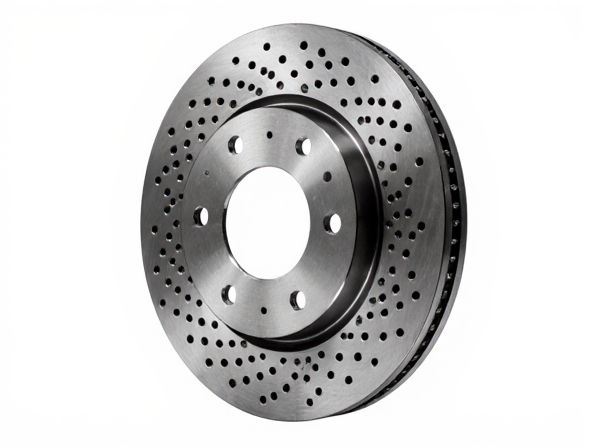
Photo illustration: Drilled Rotors vs Slotted Rotors
Drilled rotors feature holes that improve heat dissipation and enhance wet braking performance, making them ideal for high-performance driving. Slotted rotors provide better brake pad grip and help remove debris and gases from the braking surface, ensuring consistent stopping power under extreme conditions. Choosing between drilled and slotted rotors depends on your driving style and the specific demands placed on your braking system.
Table of Comparison
| Feature | Drilled Rotors | Slotted Rotors |
|---|---|---|
| Design | Holes drilled through rotor surface | Grooves or slots cut into rotor surface |
| Heat Dissipation | Improves cooling by venting heat through holes | Enhances cooling by channeling hot gases away |
| Brake Performance | Good for light to moderate braking | Better for heavy-duty, high-performance braking |
| Water & Debris Removal | Moderate effectiveness, holes clear water quickly | High effectiveness, slots clear water and debris efficiently |
| Durability | Prone to cracking under stress | More resistant to cracking and wear |
| Suitable Use | Daily driving and light sports | Performance driving, racing, and towing |
| Cost | Generally lower price | Typically higher price due to design complexity |
Introduction to Brake Rotor Types
Drilled rotors feature precision-drilled holes that enhance heat dissipation and improve braking performance by reducing brake fade. Slotted rotors incorporate grooves on the surface that help to expel gases, water, and debris, increasing friction and maintaining consistent braking power. Both rotor types target improved heat management and brake efficiency, catering to different driving conditions and performance needs.
What Are Drilled Rotors?
Drilled rotors feature precision-machined holes across the braking surface, enhancing heat dissipation and reducing brake fade during high-performance driving. These perforations also help to evacuate water, gas, and brake dust, improving wet-weather braking efficiency. However, drilled rotors may be more prone to stress fractures under extreme braking conditions compared to slotted rotors.
Understanding Slotted Rotors
Slotted rotors feature machined grooves that help remove brake dust, gas, and water from the rotor surface, enhancing brake pad contact and reducing the risk of brake fade during high-performance or heavy-duty driving. The slots improve cooling efficiency and maintain consistent braking performance, making them ideal for aggressive driving conditions or vehicles frequently exposed to wet or dusty environments. Understanding slotted rotors emphasizes their role in optimizing brake system durability and responsiveness compared to drilled rotors, which can be prone to cracks under extreme stress.
Performance Differences: Drilled vs Slotted
Drilled rotors offer superior heat dissipation and reduced brake fade due to their perforated holes, making them ideal for high-performance braking in dry conditions. Slotted rotors provide enhanced brake pad bite and improved debris and gas removal, resulting in better stopping power and consistency in wet or aggressive driving environments. Performance differences between drilled and slotted rotors center on heat management and pad contact, with drilled rotors excelling in cooling and slotted rotors excelling in maintaining grip under heavy use.
Heat Dissipation and Cooling
Drilled rotors feature holes that enhance heat dissipation by allowing hot gases and water to escape quickly, improving cooling efficiency during heavy braking. Slotted rotors, with their grooves, effectively channel brake dust and gases away from the contact surface, maintaining consistent friction and preventing heat buildup. Both designs improve brake cooling, but drilled rotors excel in rapid heat release while slotted rotors offer sustained temperature regulation under extreme conditions.
Braking Efficiency and Stopping Power
Drilled rotors enhance braking efficiency by dissipating heat more rapidly through their perforated design, reducing brake fade during intense use. Slotted rotors improve stopping power by effectively channeling brake dust, gases, and water away from the rotor surface, maintaining optimal pad contact. Both designs contribute to performance braking, but drilled rotors excel in cooling while slotted rotors prioritize consistent pad grip and debris removal.
Durability and Longevity
Drilled rotors offer enhanced heat dissipation but are more prone to cracking under extreme stress, impacting their overall durability and longevity. Slotted rotors provide superior debris removal and consistent braking performance, resulting in longer service life in demanding conditions. For durability, slotted rotors generally outlast drilled variants, especially in high-performance or heavy-duty applications.
Noise and Vibration Factors
Drilled rotors often produce higher noise levels and vibration due to air channeling through the holes, which can cause pulsations during braking. Slotted rotors provide better gas and dust expulsion, reducing brake fade and vibrations for smoother braking performance. For quieter operation with less vibration, slotted rotors are generally preferred over drilled rotors, especially in daily driving conditions.
Best Applications for Drilled and Slotted Rotors
Drilled rotors excel in high-performance applications where enhanced heat dissipation and quick water removal are crucial, making them ideal for sports cars and track racing. Slotted rotors provide superior surface cleaning and gas expulsion, making them the best choice for heavy-duty vehicles and off-road driving that demand consistent braking under harsh conditions. Choosing drilled rotors benefits aggressive, high-speed braking, while slotted rotors optimize durability and brake pad bite in rugged environments.
Choosing the Right Rotor for Your Vehicle
Choosing the right rotor for your vehicle involves understanding the benefits of drilled rotors, which offer enhanced heat dissipation and improved wet weather braking due to their perforated design. Slotted rotors provide superior brake pad cleaning by channeling dust and gases away, resulting in consistent performance during aggressive driving or towing. Consider your driving conditions and style to select drilled rotors for lighter, performance-oriented use or slotted rotors for durability and enhanced braking reliability under heavy loads.
 caratoz.com
caratoz.com